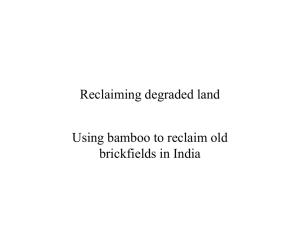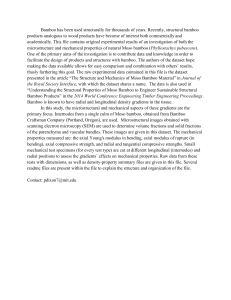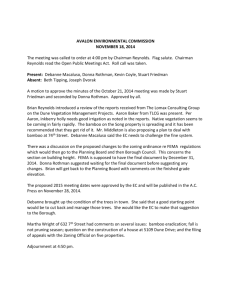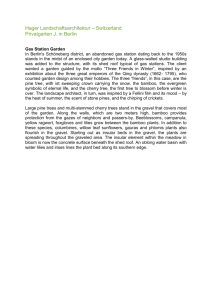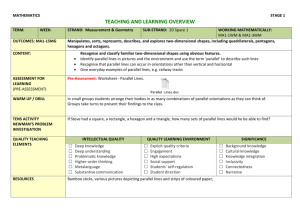Growing and Controlling Bamboo
advertisement
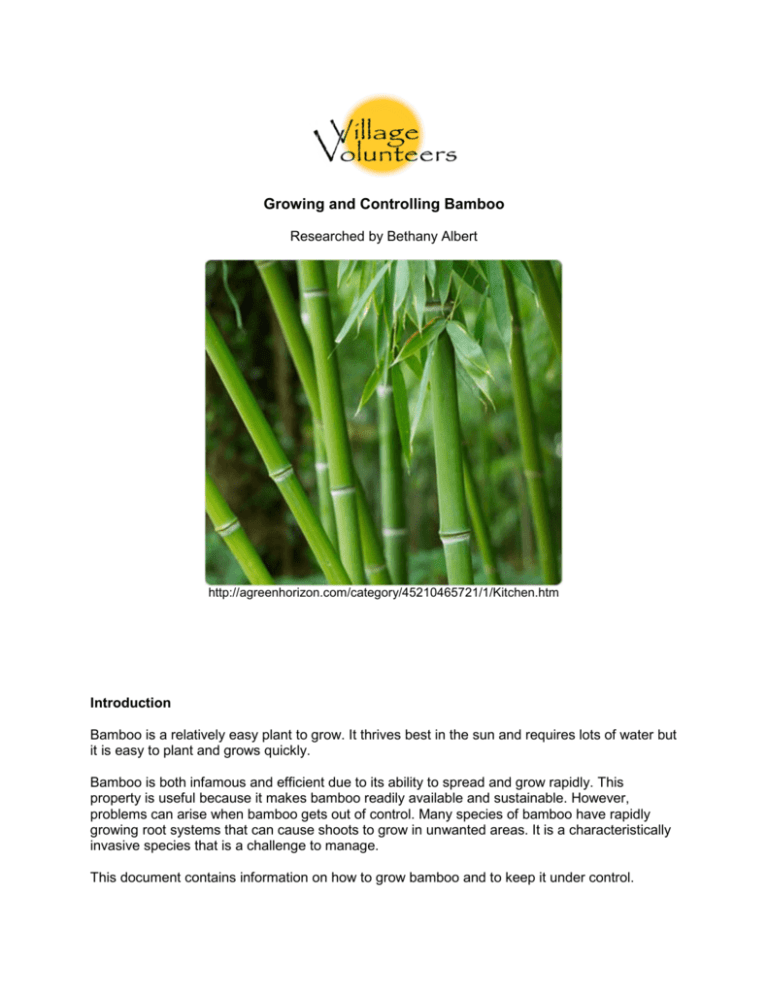
Growing and Controlling Bamboo Researched by Bethany Albert http://agreenhorizon.com/category/45210465721/1/Kitchen.htm Introduction Bamboo is a relatively easy plant to grow. It thrives best in the sun and requires lots of water but it is easy to plant and grows quickly. Bamboo is both infamous and efficient due to its ability to spread and grow rapidly. This property is useful because it makes bamboo readily available and sustainable. However, problems can arise when bamboo gets out of control. Many species of bamboo have rapidly growing root systems that can cause shoots to grow in unwanted areas. It is a characteristically invasive species that is a challenge to manage. This document contains information on how to grow bamboo and to keep it under control. Planting Bamboo From cuttings: It is best to take cuttings from the middle of a trunk of bamboo that is not more than three years old. Bamboo is segmented by nodes and the smooth space between them is called an internode. Each cutting should have two whole internodes plus a half. A A thirty foot trunk will yield about four cuttings. It is best to plant the cutting immediately to have a better chance of successful growth. Light sandy loam soils are the optimal environment to grow bamboo. Plant the cuttings vertically with the half-node on top. Applying a thin layer of damp clay around the top edges of the bamboo will serve as a disinfectant, but it is not necessary. Add two cups of water into the hollow of the bamboo and water 2-5 times a week until green shoots appear at the nodes. (Tearfund 2005). Cuttings can also be planted underground horizontally. This requires five or six whole internodes. Cut a hole into the center of an internode and keep well watered until growth occurs. (Tearfund 2005). Growing Bamboo Bamboo is a relatively tolerant plant. It does best in tropical or sub-tropical conditions, but it can also grow in the cold Himalayan mountains or in dry deserts in Africa. It enjoys lots of sunlight, but will also grow in shade. Loam soils that are slightly acidic are preferred because of their nutrient content. Rocky or soggy soils are not suitable. (Complete Bamboo 2008). Due to a shallow root system, heavy winds can easily topple bamboo over. Additionally, excessive wind can dry bamboo out. A wind barrier might be necessary. (Complete Bamboo 2008). Bamboo requires lots of water as a young shoot, and needs less as it ages. When the leaves fall, do not remove them from the ground as they act as mulch. (ABF 2010). Bamboo reaches its maximum height and width within the first growing season. This can be up to 100 feet tall and eight inches wide. Initially it ought to be watered 2-5 times a week. If the leaves start to curl, the bamboo needs more water. Conversely, too much watering can cause the plant to become waterlogged and rot. If bamboo does not have adequate nutrition, it will put its available energy into spreading its root system to find more nutrients. (Complete Bamboo 2008). Most bamboos seldom flower. Flowering is difficult to predict and oftentimes decades can pass between flowerings. It most likely occurs due to genetic factors within the particular bamboo. Flowering weakens bamboo for a few years, and sometimes can even kill it because of the energy required to perform the process. (Complete Bamboo 2008). Controlling Bamboo Bamboo’s fast-growing properties also mean that it can easily get out of control. This happens because bamboo has rhizomes, that is, stems that grow horizontally underground and then sprout new stalks vertically in unwanted areas. This tendency of bamboo can be prevented and managed with various kinds of physical barriers. Bamboo rhizome growing out of the ground http://www.completebamboo.com/Pic% 20Assets/Growing/running_rhizome.jpg Barrier: The American Bamboo Society recommends installing barriers (concrete, metal, or plastic sheets) thirty inches deep around plants to keep the underground root systems from spreading. It must also protrude a few inches above the soil. Barriers must go deeper if the soil is loose or there are pockets of air that would allow the runners to go under the barrier. Make sure the barrier slants outward at the top so that when roots hit it they move upwards instead of down under the barrier. Trench: Digging a trench around the bamboo is also an option. Make the trench about eight to ten inches deep and twelve inches wide around the bamboo and check in the fall and spring to see if rhizomes (the underground stems) have tried to cross the trench. Cut and remove them if they have. The trench around the plants can also be filled with gravel in order to prevent unwanted spreading. Cutting rhizomes twice a year should be sufficient management. (Bamboo Garden 2010). Water: A pond or stream can also be an effective natural barrier to the spreading of bamboo. www.bamboogarden.com/barrier%20installation.htm Removing Bamboo If bamboo has spread where it is not wanted already, there are steps that can be taken to remove it. Herbicides are ineffective when it comes to bamboo, and thus they are a waste of time and money. Cutting: The American Bamboo Society recommends the following procedure: 1. Cut the grove down to the ground, except for the portion you wish to keep. A grove of bamboo, contrary to the general idea that every bamboo stalk (culm) is a different tree, is usually just one plant. All of the stalks are interconnected underground by horizontal shoots. Thus, make sure that the section you wish to kill or remove is separate from the section you wish to keep. This can be done by cutting the rhizomes with a spade or a shovel. Rhizomes are generally within the first few inches of soil, unless it is exceptionally loose dirt. 2. Water and fertilize the area, to cause new growth. This is desirable because doing this cutting process repeatedly will exhaust the energy stored within the rhizomes underground. Break off or cut off the new shoots. By removing the shoots, the rhizomes will lose their source of photosynthesis (and therefore new energy). They will no longer be able to grow new shoots and the rhizomes remaining will eventually rot away. 3. Immediately remove new shoots that come up. Repeat until no more new shoots come up. Digging: Due to how labor intensive this method is, the digging method is effective for small patches of bamboo. Dampen the soil first, and then begin digging around the base of a shoot. When the soil is sufficiently loosened, gently pull the plant out. Since bamboo spreads through its horizontal rhizomes, the goal is get as much of this underground root system out with the stalk as possible. Loosening the soil and removing the plant gently with wiggling maximizes this. Perform this procedure shoot by shoot. Unavoidably, some rhizomes will be left behind that will sprout more shoots and the process must be repeated. (Beaulieu 2010). Smothering: Covering a shorn patch of bamboo with a tarp can prevent shoots from coming back up by not letting sunlight reach them. However, this method is inconsistent because it is difficult to evaluate just how far the rhizomes have spread underground and therefore shoots may sprout outside the tarp-covered area. (Beaulieu 2010). Sources and Resources “American Bamboo Society. “General Bamboo Info.” 2010 http://www.americanbamboo.org/GeneralInfo.html Bamboo Garden. “Techniques for Maintaining and Pruning Bamboo.” 2010 www.bamboogarden.com/barrier%20installation.htm Bamboozled. “Rhizome Barrier in Ground.” 2010. http://bamboozled.info Beaulieu, David. “Is Bamboo Eradication Possible Without Herbicides?” 2010 http://landscaping.about.com/od/tropicalplants/f/remove_bamboo.htm Complete Bamboo. 2008. www.completebamboo.com Tearfund International Learning Exchange. “Growing Bamboo.” 10 August 2005 http://tilz.tearfund.org/Publications/Footsteps+21-30/Footsteps+23/Growing+bamboo.htm • • • For PDF documents such as: Bamboo Rat Trap Bamboo Water Pipes Growing Bamboo Village Volunteers 206.577.0515 • info@villagevolunteers.org www.villagevolunteers.org
